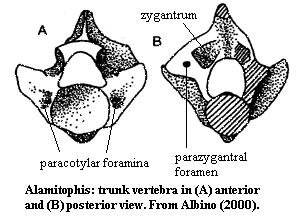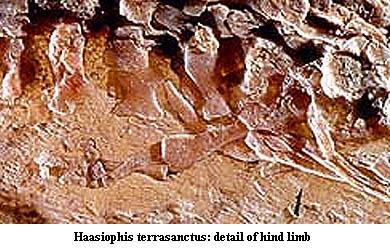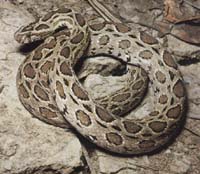
| Palaeos |  |
Squamata |
| The Vertebrates | Pythonomorpha: Macrostomata |
| Page Back | Unit Home | Unit Dendrogram | Unit References | Taxon Index | Page Next |
| Unit Back | Vertebrates Home | Vertebrate Dendrograms | Vertebrate References | Glossary | Unit Next |
|
Abbreviated Dendrogram
SQUAMATA |--Iguania Scleroglossa | Pythonomorpha |--Mosasauroidea `--Serpentes |--Scolecophidia `--Alethinophidia |--Aniloidea `--Macrostomata |--Madtsoiidae `--+--Pachyophiidae `--+--Boidae `--Caenophidia |--Acrochordoidea `--Colubroidea |--Colubridae `--Viperidae |
Contents
Overview |
Macrostomata: Crotalus > Anilius. snakes with large gapes (boas, cobras, vipers)
Range: fr upK worldwide.
Phylogeny: Alethinophidia:: Aniloidea + *: Madtsoiidae + (Pachyophiidae + (Boidae + Caenophidia))
Characters: $ enlorged posterodorsal toothed process of dentary [Z98]; toothed anterior process of pterygoid [Z98]; $ basipterygoid processes reduced, with articulating surface facing ventrally [Z98]; $ free-ending process of supratemporal [Z98]; $ dorsal surface of prootic concealed by supratemporal [Z98]; quadrate vertical or posteriorly directed [Z98]; $ quadrate suprastapedial process absent (except Xenopeltis) [Z98];
References: Zaher (1998) [Z98]
 Madtsoiidae:
Alamitophis, Gigantophis (~9m! see image at fossili),
Wonambi. Some very large. Mostly known from isolated vertebrae.
Madtsoiidae:
Alamitophis, Gigantophis (~9m! see image at fossili),
Wonambi. Some very large. Mostly known from isolated vertebrae.
Range: mK-lwPle of Gondwana (SAm, Aus. & Egypt). Latest South American finds are of Ec age.
Phylogeny: Macrostomata: (Pachyophiidae + (Boidae + Caenophidia)) + *.
Characters: generally cylindrical body[C&A]; skull long & low [S&L]; upper jaw tightly fixed to skull [S&L]; palate very broad [S&L]; palatine in extensive contact with vomer [S&L]; small facets on pterygoids for basipterygoid articulation; snout rounded [S&L]; ligamentous maxilla - premaxilla connection [S&L]; prefrontal sutured to maxilla, but movable on frontal [S&L]; frontal - nasal articulation sutured and rigid [S&L]; jugal probably retained [S&L]; supratemporal and/or quadrate projected posteriorly [S&L]; braincase narrow betwen orbits, widening posteriorly [S&L]; paracotylar foramina present; $ "parazygantral foramina" (i.e. foramina on the vertebrae lateral to the zygantra) [A]; prezygapophyseal processes absent; synapophyses (?!) located low from centrum [A][S&L]; tall, narrow vertebrae with single hypapophyses on anterior trunk [S&L]; vertebrae elongate and become lower more posteriorly [S&L]; trunk ribs curved throughout, with proximal facets slightly constricted between diapophyseal & parapophyseal processes; no limb or girdle elements [S&L].
Links: Faiyum introduction; fossili (Italian); Faiyum 2nd; News in Science 27/01/00 First snakes may have come from the water (Wonambi); A twist in the tail of snake evolution (Best on the Web); un485.pdf (third page); ABC Online Forum (comment from "eric").
References: Albino (2000) [A]; Caldwell & Albino (2001) [C&A]; Scanlon & Lee (2000) [S&L]
Note: Apparantly, the only decently known madtsoiid is Wonambi. Thus the characters above are almost all apomorphies of Wonambi.
 Pachyophiidae:
Haasiophis, Pachyophis, Pachyrachis, Podophis.
Pachyophiidae:
Haasiophis, Pachyophis, Pachyrachis, Podophis.
Range: mK-upK of the Middle East & E.Eur.
Phylogeny: Macrostomata:: (Boidae + Caenophidia) + *.
Characters: up to 1.1 cm, with laterally compressed bodies [C&A]; probably wide gape [C&A]; pterygoids with teeth [T]; toothbearing process of dentary long [T]; long, recurved pterygoid teeth [C&L]; mandible not fused; $ intramandibular joint anterior (Pachyrachis) [C&L]; angular not exposed on medial surface of jaw [C&L]; $ large rectangular coronoid process (Pachyrachis) [C&L]; palatines do not contact ectopterygoid [T]; transverse process of pterygoid gently curved and receives ectopterygoid on lateral surface [T]; lateral edge of ectopterygoid not straight [T]; anterior end of ectopterygoid invades surface of maxilla, approaching posteroventral corner of orbit [T]; reduced basipterygoid processes [C&L]; lacrimal absent [C&L]; ventral tip of postorbital contacts (or almost contacts) ectopterygoid, completing orbital margin [T]; postorbital & postfrontal fused (Pachyrachis & maybe Haasiophis) [C&L]; supratemporal process of parietal not well developed [T]; "free ending" (?) process of supratemporal present [T]; braincase completely encased; prootic fully concealed by supratemporal or parietal in dorsal view [T]; quadrate vertical (cephalic condyle & mandibular condyle at same anteroposterior level) [T]; no or vestigial stapedial process of quadrate cephalic condyle [T]; $ quadrate anteroposteriorly expanded (Pachyrachis) [C&L]; ~140 trunk vertebrae; pachyostotic mid-dorsal vertebrae & ribs [C&L] [C&A]; well-developed hindlimb, with pelvis outside ribs; may have sacrum [C&L]; femur, tibia, fibula and some tarsals present; astragalus & calcaneum not fused [C&L]; inhabited sheltered marine reef environments [C&A].
Links: ScienceDaily Magazine: New Fossil Snake With Legs; Argument About Snake Evolution Rekindled by Fossil; SNAKES.SMU.
Reference:Caldwell & Albino (2001) [C&A]; Caldwell & Lee (1997) [C&L]; Lee et al. (1999); Tchernov et al. (2000) [T]; Zaher (1998).
Note: [1] The characters above from [T] include only derived features, shared by both known genera. [T] also identify 3 synapomorphies of this group: $ outer orbital (lateral) margin of prefrontal slanting anteroventrally; $ ascending process of maxilla well-developed; $ coronoid process from coronoid bone only. All 3 are supposed reversals, and one might guess that the first two are correlated. This is indeed a weakly supported group. However, the derived characters do include strongly consistent (CI=1) macrostomate synapomorphies, so the paper's central conclusion -- that the 'Ein Yabrud specimens are macrostomates -- is well supported. [2] There now appears to have been a thriving and diverse community of Cretaceous marine snakes on both the Northern and Southern margins of the Tethys Sea in Late Cretaceous times. [C&A]. C&A note that the Southern population necessarilly places this group close in time and space to the Gondwanan madtsoiids. 010901.
Boidae: boas & pythons.
Range: fr upK.
Phylogeny:Macrostomata::: Caenophidia + *.
Characters: Squamosal and quadrate lengthened. Few diagnostic features: intermediates between Scolecophidia and advanced snakes.
Links: The Boa Constrictor Subspecies.
 Caenophidia:
(= Xenophidia = Colubroidea) "advanced," poisonous snakes and
relatives
Caenophidia:
(= Xenophidia = Colubroidea) "advanced," poisonous snakes and
relatives
Range: fr Ec?; cosmopolitan
Phylogeny:Macrostomata::: Boidae + *: Acrochordoidea + Colubroidea.
Characters: complete absence of pelvic girdle.
Links: Snakes; Caenophidia after Gravlund, 2001. 011105.
Acrochordoidea:Wart or file snakes, Acrochordus.
Range:?
Phylogeny: Caenophidia: Colubroidea + *.
Characters: Like advanced snakes in mobility of jaw; primarily aquatic; scales parallel(?), secondarily(?) reduced ventral scales. ATW991003.
| Page Back | Unit Home | Page Top | Page Next |
checked ATW060222